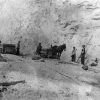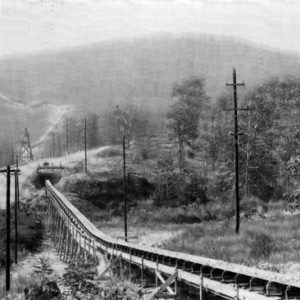calsfoundation@cals.org
Sand and Gravel Mining
aka: Gravel and Sand Mining
Sand is usually defined as an accumulation of mineral grains in sizes ranging from one-sixteenth to two millimeters. Sand normally consists predominantly of quartz grains of variable degrees of roundness. Other mineral grains within the sand size range are also present and typically consist of feldspar, chert, ilmenite, and other less abundant resistant minerals. Gravel is considered to be an unconsolidated mixture of rock fragments, pebbles, cobbles, and boulders of indefinite size, but always larger than sand-sized materials. Gravel normally consists of a mixture of rock types, depending upon the original source, and may consist of various quartz rock varieties, such as chert, sandstone, novaculite, agate, and milky vein quartz, as well as limestone, dolostone, and other resistant rock types.
Deposits of sand and gravel are widely distributed across all of Arkansas and are currently mined in about three-quarters of Arkansas’s seventy-five counties. Major deposits are present as sedimentary units, on talus slopes, and as alluvial deposits in the flood plains, beds, and terraces of rivers and streams. Most of these unconsolidated deposits may be mined from open pits (open cut methods). Certain areas of the state are particularly notable for the abundance of these resource materials. Some units of Early Cretaceous age in Pike, Howard, and Sevier counties contain significant beds of sand and gravel, especially the Pike Gravel and Ultima Thule Gravel members of the Trinity Formation, which range in thickness from twenty to 100 feet and zero to forty feet, respectively. Units of Late Cretaceous age that contain abundant sand and gravel are the Woodbine, Tokio, and Nacatoch formations. Sand and gravel deposits are present in the Woodbine Formation in Howard and Sevier counties. The Tokio contains recoverable sand and gravel in Clark, Pike, Howard, and Sevier counties. Sand beds are present in the Nacatoch Formation in Clark, Hempstead, and Howard counties. Quaternary gravel deposits are abundant in interstream divides of the Gulf Coastal Plain in southern Arkansas and on Crowley’s Ridge in northeast Arkansas.
Gravel and sand deposits on Crowley’s Ridge extend from St. Francis County northward to the Arkansas-Missouri state line. Extensive Quaternary alluvial deposits of sand and gravel are present in the major river systems in the state. Dredging operations in the rivers, especially the Arkansas River, recover significant amounts of sand and gravel. Also, deposits are present locally within or adjacent to the beds of the smaller rivers and streams in the state. Significant deposits of cherty clay and sandy regolith in north Arkansas are utilized for road and construction fill material. In these deposits, rock fragments vary from rounded to highly angular.
Methods of mining sand and gravel depend upon the size and type of deposit but most often consist of open cuts. Sand and gravel deposits not only contain variable percentages of sand- and gravel-sized materials but often contain considerable clay. Depending on the desired properties of the material, clay content may be either a plus or a minus to the user. Open-pit mines may be worked by heavy equipment, including bulldozers, scrapers, power shovels, and draglines. For graded product, a washing and sorting (grading) plant with washing and sizing screens is employed. Washing and sizing of the material is a necessity to meet stringent size specifications. Product may be transported by truck or by rail.
Major uses for construction sand and gravel include concrete aggregate; concrete products, including block, brick, and pipe; aggregate in asphalt and other bituminous mixtures; road-base material and road coverings; construction fill; snow and ice control; filtration purposes; and railroad ballast. Clay-based sand and gravel are often used for county road maintenance on unsurfaced roads throughout the state. The Arkansas Department of Transportation sets specific standards relating to the performance of construction materials, including sand and gravel used in Arkansas’s highway projects. Use of specific deposits of sand and/or gravel depends upon the performance of these materials in standardized engineering tests, including, but not limited to, size distribution, abrasion resistance, grain shape (roundness), and percentage of admixed fines (silt or clay).
Worldwide, more sand and gravel is mined annually than any other industrial raw material. Preliminary estimates of sand and gravel production in Arkansas for 2007 by the U.S. Geological Survey are nearly 9.1 million metric tons valued at $66,300,000. Nearly fifty percent was used for concrete aggregate and concrete products. Large tonnages were also used for aggregate in asphalt (and other bituminous mixtures) and for road-base material and rural road coverings.
Sand and gravel are considered high-volume, low-unit-price natural materials. Due to the high cost of transportation of this resource relative to its unit price, the commodity is produced in many counties within Arkansas for local construction work. From 1995 through 2005, the sand and gravel industry within Arkansas underwent major changes, resulting in the replacement of numerous local operations by major national companies and later closing of many sites. There still remain many small operations for local use, however, with major producers on larger operations being strategically located across Arkansas. As of year-end 2008, there were 123 permitted sites that produced sand and gravel in Arkansas. Active operators include Arkansas Gravel Company; CES Gravel; Fowler Sand & Gravel; Joey Baker; APAC Central, Inc.; Arkhola; Jeffrey Sand; Rock Connection; Sheridan White Rock; White River Materials, Inc.; Hanson Aggregates West; Standard Gravel Company, Inc.; B & B Materials LLC; and RazorRock.
For additional information:
Arkansas Department of Environmental Quality. http://www.adeq.state.ar.us (accessed February 22, 2022).
“Industrial Minerals.” Arkansas Geological Survey. https://www.geology.arkansas.gov/minerals/industrial.html (accessed February 22, 2022).
Stroud, R. B., R. H. Arndt, F. B. Fulkerson, and W. G. Diamond. Mineral Resources and Industries of Arkansas. U.S. Bureau of Mines Bulletin 645. Washington DC: U.S. Department of the Interior, 1969.
USGS 2007 Minerals Yearbook, Arkansas. U.S. Geological Survey. http://minerals.usgs.gov/minerals/pubs/state/2007/myb2-2007-ar.pdf (accessed February 22, 2022).
J. Michael Howard
Mabelvale, Arkansas
 Industrial Sand Mining
Industrial Sand Mining Bull Shoals Dam Conveyer Belt
Bull Shoals Dam Conveyer Belt 




Comments
No comments on this entry yet.